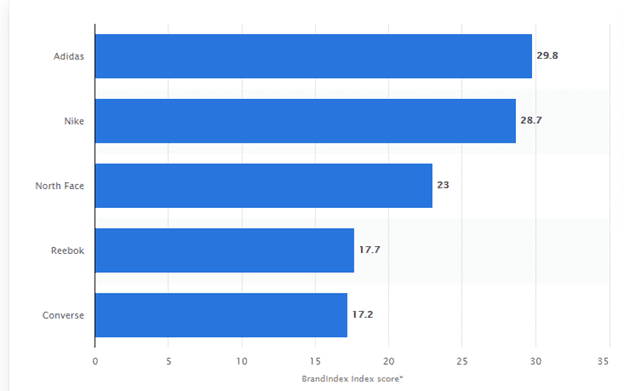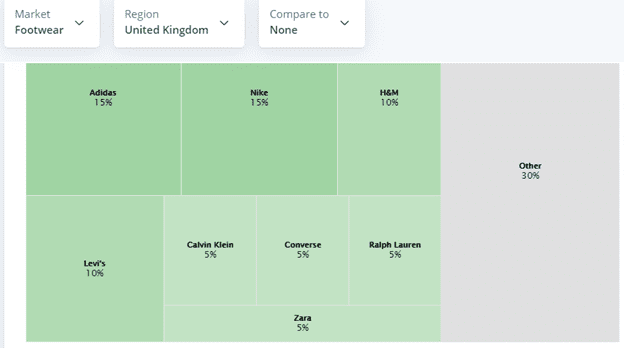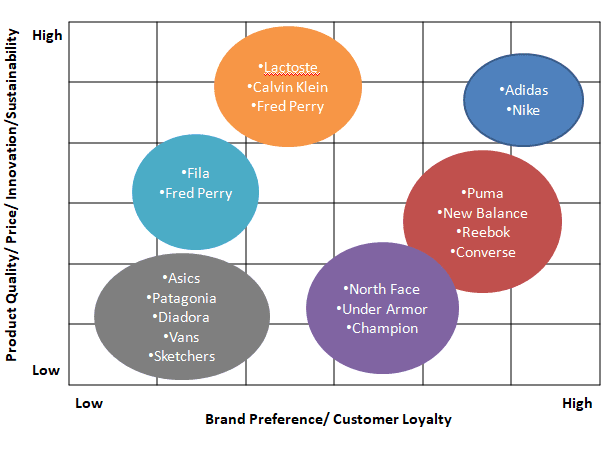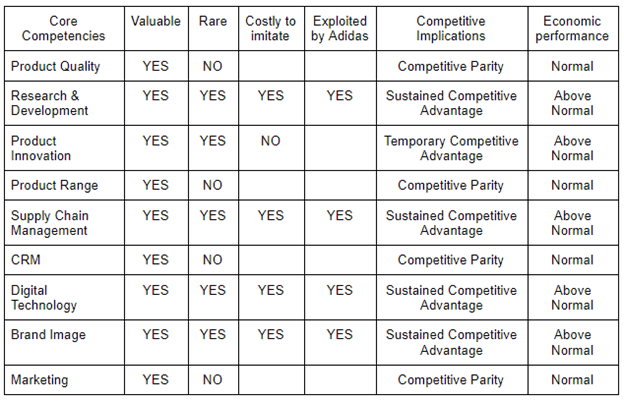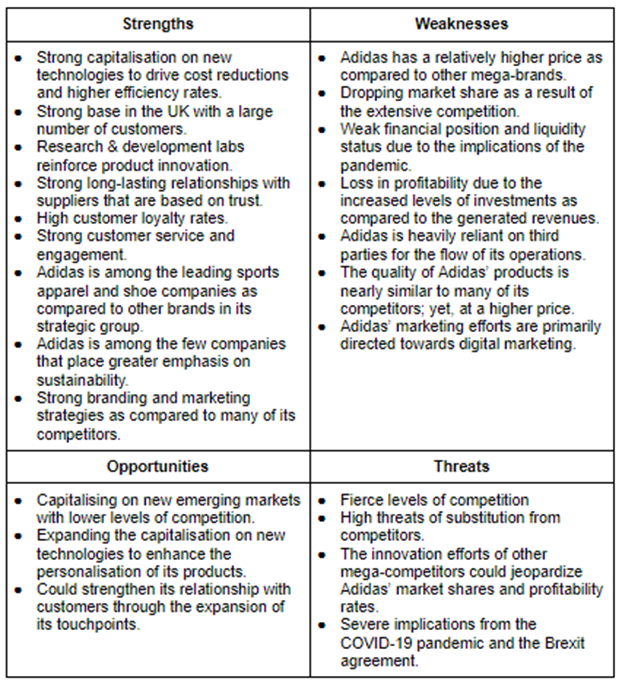1 Introduction
With the rapid evolution of the business world, maintaining a sustainable competitive advantage through effective strategies is crucial to ensure growth and profitability. As stated by López & Guerras-Martín, (2018), strategic analysis and management draw on three main theories namely, the “Industrial Organisation” theory which focuses on the organisation’s external environment, the “Resource-based” theory which focuses on the internal environment, and the “Contingency” theory which combines both external and internal environments. Accordingly, this report presents an extensive analysis of Adidas’ external and internal environment in an attempt to provide recommendations that would inform future strategic decisions. In doing so, the analysis would focus on sports apparel and shoes as part of the UK.
2 Diagnosis
To start with, Adidas is a world-leading global sports brand that specialises in the manufacturing of different footwear, apparel, accessories, and other sports-related equipment (Mahdi et al., 2015). As stated in their website, the company’s business strategy “puts the consumer at the heart of everything” (Adidas, 2021). Thus, its business strategy is enabled through a differentiation-based approach that is based on product innovation, sustainability and digital transformation (Adidas, 2021).
Nevertheless, the COVID-19 pandemic has caused dramatic changes in the manufacturing and retail industries across the globe causing severe disruptions in the supply, demand and daily operations of both small and large businesses (OECD, 2020). To illustrate, concerning business issues, severe drops in demands and sales levels in the UK were realised during the pandemic with a massive increase in online purchases (ONS, 2021). Thereby, causing multiple uncertainties in the projected demands affecting production, inventory management and supply chain management.
With regards to organisational issues, the manufacturing sector has realised multiple disruptions in its daily operations (OECD, 2020). Thus, the enforced protective measures in the UK, and across many other countries, have severely affected workflow, productivity levels and liquidity (ONS, 2021). Moreover, other political issues were also encountered as a result of the enforced laws and regulations such as border restrictions leading to sourcing and supply chain challenges (OECD, 2020). It is worth noting that these issues followed the yet-to-be-healed impacts of the Brexit agreement on the manufacturing industry, in terms of aspects such as import/export, labour availability, etc. (Deloitte, 2020).
Thus, the aforementioned factors act as the main driver for many businesses to rethink their strategies, business models, internal processes and core competencies to enhance their resilience and retain a competitive advantage over their competitors. The following analysis would provide an insight into the threats and future opportunities that Adidas could capitalize on in its future strategic direction.
3 Strategic Analysis
3.1 Industry Analysis
3.1.1 Porter’s Five Forces
As acknowledged by Porter, there are five main competitive forces that collectively shape the nature of competitive interaction within industries (Porter, 2008).
3.1.1.1 Substitute products
According to Porter, a substitute product “performs the same or a similar function as an industry’s product” (Porter, 2008, p.31). Adidas has very high threats of substitutes to its sports product from competitors. This is further driven by the fact that customers do not incur any substitution costs.
Figure: Leading sports brands in the UK by Brandindex Score in 2019. Source: (Statista, 2021).
3.1.1.2 Entry of new competitors
This force demonstrates the propensity of new competitors entering the market and impacting the market share (Person, 2013). Adidas has no threat from new competitors as attaining customer loyalty, economies of scale and accessing distribution channels would be challenging for new entrants.
3.1.1.3 Competitive rivalry
The increased competition from rivalries through price discounting and quality improvements could affect companies with lower competitive strengths (Porter, 2008). Adidas has several competitors who provide high quality innovative and cheap sports that are attractive to customers.
Figure: Emerging sportswear brands in the United Kingdom (UK) in 2020, based on the change in consumer interest. Source: (Statista, 2021).
3.1.1.4 Consumer bargaining power
This force is the extent to which consumers could force a company to lower its prices (Person, 2013). Since there is a limited number of competitors providing differentiated products at low prices, consumers have low bargaining power.
3.1.1.5 Supplier bargaining power
Suppliers are capable of influencing the profitability of businesses through increasing the prices of raw materials and/or limiting the quality, etc. (Porter, 2008). Since Adidas is considered to be a major customer to suppliers, they tend to rather ensure a strong long-lasting relationship with the company. Therefore, they possess a low bargaining power.
3.1.2 Strategic Group Analysis
As defined by (Porter, 1980), strategic groups are “groups of firms within the same industry utilising a similar strategy along with a set of strategic dimensions” (p.129). Thus, strategic group analysis constitutes a major step towards the understanding of the different strategy positions of competitors (Porter, 1980). The analysis would be based on the following strategic characteristics.
3.1.2.1 Product Quality
Adidas, Nike, Puma, Lacoste, Fila, Asics and New Balance focus on providing consumers with a high-quality product through intensive quality management and control practices.
3.1.2.2 Product Innovation
Adidas, Nike, Fila and Puma focuses primarily on providing customers with innovative and differentiated products through extensive research and development efforts.
3.1.2.3 Price
Asics, Reebok, Converse, Skechers, Champion, Under Armor, Vans and Diadora focus on providing consumers with value products at relatively lower prices.
3.1.2.4 Sustainability
Adidas, Asics, the North Face, and Patagonia have integrated sustainability into the core of their business strategies through the use of recycled materials and addressing energy and water efficiency.
3.1.2.5 Brand preference
Adidas, Nike, and Converse are amongst the most preferred sports footwear brands in the UK as of 2021 (Statista, 2021).
Figure: The most preferred footwear brands in the UK. Source: (Statista, 2021).
3.1.2.6 Customer Loyalty
Adidas, Nike, Puma, Converse, Reebok, and New Balance, have the highest number of loyal customers according to sales ratings (Statista, 2021).
Figure: Sports brands ranking in the UK by the number of consumers. Source: (Statista, 2021).
3.1.3 Strategic Group Map
Figure: Strategic Group Map of Adidas.
3.2 Resource/Competence Analysis
3.2.1 Value Chain Analysis
3.2.1.1 Primary Activities
Primary activities are directly related to the production of products and are considered as a source of cost advantage (Porter, 1985).
- Inbound and outbound logistics: Adidas extensively outsources its manufacturing from outside suppliers across the globe to reduce costs (Adidas, 2021); which could lead to multiple disruptions in the supply chain and item delivery during the pandemic. It also has 64 distribution channels, of which 27 are owned by the company (Adidas, 2021).
- Operations: Adidas has an extensive network of stores and warehouses in the UK allowing it to expand and reach all targeted consumers. This is further complemented by company-owned customer touchpoints including retail stores and e-commerce channels (Adidas, 2021).
- Marketing & Sales: Adidas is placing greater emphasis on digital marketing to drive sales (Adidas, 2021). This is further supported by the massive increase in e-commerce sales in the UK in the past few years.
3.2.1.2 Secondary Activities
Secondary activities, also known as support activities, have a role across all primary activities. They are primarily considered as a source of differentiation advantage (Porter, 1985).
- Procurement: Since Adidas depends on outsourcing from external suppliers, it places greater emphasis on forming long-lasting relationships that are built on trust and mutual benefit (Adidas, 2021).
- Technology: Adidas is exerting massive efforts towards digital transformation to increase its efficiency, productivity and profitability while reducing costs and wastes (Adidas, 2021).
- Human Resource Management: Adidas places great emphasis on HRM to appoint and promote the right people to drive innovation. It also focuses on leadership capability, employee engagement and ways of working (Adidas, 2021).
- Infrastructure: Adidas is currently capitalising on key technology infrastructure and the expertise necessary to operate them. The company also has other departments such as R&D, quality assurance and general management (Adidas, 2021).
3.2.2 VRIO Framework
The VRIO framework aims to evaluate the competitive resources and capabilities of a business. According to the framework, there are four main attributes that, if possessed by a capability, would lead to a sustainable competitive advantage (Grant et al., 2014). The evaluation of such capabilities is done according to the graph shown hereunder.
Figure: VRIO Framework. Source: (Grant et al., 2014).
Table: Adidas VRIO Analysis.
From this analysis, it is evident that the research and development efforts, supply chain management, digital technology and brand image are among the most valuable core competencies of Adidas. Adidas has strong branding strategies that place emphasis on customers and commitment to the community as a whole. The research lab paves the way for the production of innovative products to increase sales, profitability and market share. The effective SCM also guarantees Adidas a cost advantage, enhanced delivery precision, lower inventory, administrative and other costs, and strength to penetrate new markets. Finally, Adidas has an effective CRM by relying on big data and data analytics, and other technologies such as “Cloud-native, micro-service architecture” to build strong connections with its customers
3.3 SWOT Analysis
3.3.1 Strengths
Adidas seems to possess multiple strengths that advantage it with a sustainable competitive edge as compared to its competitors. The primary forms of Adidas’ strengths are manifested in relation to its customer base, brand image, sustainability efforts, digital technologies, supply chain management, research and development and customer service (Adidas, 2021).
3.3.2 Weaknesses
Nevertheless, Adidas also has a few weaknesses which are primarily evidenced in its price and quality levels as compared to other mega-competitors, the implications of which have affected its market share and profitability rates. This has further been magnified by the implications of the pandemic that cause multiple weaknesses in its financial and liquidity status (Adidas, 2021).
3.3.3 Opportunities
Adidas has multiple opportunities to capitalise on the most important of which are accessing emerging markets, enhancing customer personalisation efforts and further strengthening its relationship with customers through the expansion of its touchpoints.
3.3.4 Threats
The main threats facing Adidas emerge from the fierce competition levels and high threats of substitutes. This has further been magnified by the implications of the pandemic and the Brexit agreement (Adidas, 2021).
Table: SWOT analysis of Adidas.
4 Recommendations
4.1 Generic Competitive Strategy (GCS)
According to Porter, (1985), there are three main generic strategies that are applicable to all businesses in all industries namely, cost leadership, differentiation and focus. The primary focus of cost leadership is attaining a competitive advantage through cost reductions. The main focus of differentiation is to differentiate products from competitors and finally, the focus strategy is related to the targeting of niche markets. It is evident that Adidas’ current strategy is based on the integration of cost leadership through digital technologies and differentiation through product innovation. Yet, it is still besieged by high competition levels. Therefore, Adidas should consider the targeting of new niche segments, such as older women and people with special needs.
Figure: Generic competitive strategy framework. Source: (Porter, 1985).
5 Evaluations
The proposed new strategy is practically feasible and applicable to Adidas for the following reasons. Adidas already has the needed knowledge, technical expertise and knowledge, and the needed technology that could facilitate the targeting of new niche segments. Thus, no additional costs would be incurred besides researching the targeted segment’s needs and preferences. Not only would such expansion allow Adidas to further diversify and extend its customer base but also, it would allow it to diversify its sources of revenues. Such diversification would enhance the company’s resilience and profitability rates. Furthermore, the targeting of new segments that have been neglected on the basis of inferiority would further reveal the company’s support to the community as a whole; thereby, enhancing its reputation and sustainability.
6 Conclusions
To conclude, regardless of the current success and market position of Adidas, the implementation of changes to its strategies is of great significance. This would enhance the resilience and adaptability of the company by allowing it to take actions that align with the changes in its external environment.
8 Appendices
Table: Adidas VRIO Analysis.
| Core Competencies | Valuable | Rare | Costly to imitate | Exploited by Adidas | Competitive Implications | Economic performance |
| Product Quality | YES | NO | Competitive Parity | Normal | ||
| Research & Development | YES | YES | YES | YES | Sustained Competitive Advantage | Above Normal |
| Product Innovation | YES | YES | NO | Temporary Competitive Advantage | Above Normal | |
| Product Range | YES | NO | Competitive Parity | Normal | ||
| Supply Chain Management | YES | YES | YES | YES | Sustained Competitive Advantage | Above Normal |
| CRM | YES | NO | Competitive Parity | Normal | ||
| Digital Technology | YES | YES | YES | YES | Sustained Competitive Advantage | Above Normal |
| Brand Image | YES | YES | YES | YES | Sustained Competitive Advantage | Above Normal |
| Marketing | YES | NO | Competitive Parity | Normal |
Table: SWOT analysis of Adidas.
| Strengths | Weaknesses |
| ● Strong capitalisation on new technologies to drive cost reductions and higher efficiency rates.
● Strong base in the UK with a large number of customers. ● Research & development labs reinforce product innovation. ● Strong long-lasting relationships with suppliers that are based on trust. ● High customer loyalty rates. ● Strong customer service and engagement. ● Adidas is among the leading sports apparel and shoe companies as compared to other brands in its strategic group. ● Adidas is among the few companies that place greater emphasis on sustainability. ● Strong branding and marketing strategies as compared to many of its competitors. |
● Adidas has a relatively higher price as compared to other mega-brands.
● Dropping market share as a result of the extensive competition. ● Weak financial position and liquidity status due to the implications of the pandemic. ● Loss in profitability due to the increased levels of investments as compared to the generated revenues. ● Adidas is heavily reliant on third parties for the flow of its operations. ● The quality of Adidas’ products is nearly similar to many of its competitors; yet, at a higher price. ● Adidas’ marketing efforts are primarily directed towards digital marketing. |
| Opportunities | Threats |
| ● Capitalising on new emerging markets with lower levels of competition.
● Expanding the capitalisation on new technologies to enhance the personalisation of its products. ● Could strengthen its relationship with customers through the expansion of its touchpoints.
|
● Fierce levels of competition
● High threats of substitution from competitors. ● The innovation efforts of other mega-competitors could jeopardize Adidas’ market shares and profitability rates. ● Severe implications from the COVID-19 pandemic and the Brexit agreement. |





